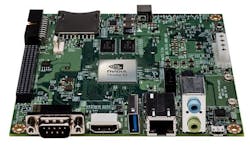NVIDIA Jetson TK1 kit enables local analysis of data captured by UAS, satellites
SAN JOSE, Calif., 27 March 2014. More than 3,500 professionals flocked to NVIDIA’s GPU Technology Conference (GTC), where NVIDIA CEO and Co-Founder Jen-Hsun Huang introduced the NVIDIA Jetson TK1 Developer Kit, enabling software developers and engineers to harness mobile processors for the advancement of avionics and other embedded systems.
NVIDIA’s new developer platform, based on a mobile supercomputer for embedded systems, will assist in the development of systems and applications that employ computer vision, image processing, and real-time data processing. Aerospace and defense use cases include enabling robots to seamlessly navigate and drones to avoid moving objects, officials say.
Modern aerospace electronics systems harness the power of compute processing units (CPUs) and graphics processing units (GPUs) working in tandem. NVIDIA GPUs have been adopted for myriad aerospace and defense applications, from signal processing to digital forensics to image and video analytics of data captured by satellites and unmanned aircraft systems (UAS).
“GPUs are used to perform local analytics, too, to do pre-analysis of the data and even collision avoidance in an unmanned aerial vehicle (UAV),” describes Sumit Gupta, general manager of Tesla GPU accelerated computing business at NVIDIA in Santa Clara, Calif.
“The vision of the defense world is that every warfighter will have a handheld device and computing devices in every aircraft, Humvee, and tank,” Gupta affirms. The vision of the U.S. Department of Defense (DOD) encompasses “hundreds of thousands of sensors sending data on the battlefield–including sensors on the ground, in the air, and on satellites, as well as analysis and data crunching done in the field without being connected to a back-end server.”
Such aerospace applications “require very high computing capabilities but they are limited by power,” Gupta adds. To fulfill this need, NVIDIA is bringing mobile chips into the aerospace embedded market to provide very high compute density, hundreds of gigaflops of performance within a few watts.
The new Jetson TK1 DevKit harnesses Tegra K1 compute capabilities to usher in and enable new computer-vision, image processing, and real-time data processing applications in aerospace and defense, including robotics and avionics. Applications also exist in the automotive and medical markets, officials say. NVIDIA’s embedded developer kit is “completely changing the compute capabilities; the use cases are unimaginable” and far-reaching, Gupta enthuses.
The DOD and defense contractors have already shown interest, saying NVIDIA mobile chip technology delivers the exact computing density needed for the embedded defense market. “The mobile industry is driving innovation for compute which we can now use in military environments to meet the need for local computing,” Gupta says.
“The NVIDIA Jetson TK1 Developer Kit provides developers with the tools to create systems and applications that can enable robots to seamlessly navigate [and] drones to avoid moving objects,” according to a company spokesperson. The NVIDIA Jetson TK1 Development Kit, priced at $192, is available from NVIDIA, Microcenter, and Newegg in the U.S.; from Avionic Design, SECO, and Zotac in Europe; and Ryoyo Electro Corp. in Japan.
"Having the level of performance and energy efficiency Jetson TK1 offers can potentially support the development of robots with real-time object recognition and compelling autonomous navigation capabilities. Our experience with the previous generation CUDA development kit has already enabled us to make great progress training robots to interact more intelligently with their environment," says Chris Jones, director of strategic technology development at iRobot Corp. in Bedford, Mass.
"Tegra K1 can change what's possible in the rugged and industrial embedded market,” says Simon Collins, product manager at GE Intelligent Platforms in Charlottesville, Va. “We expect to be able to offer solutions in the sub-10 watt space that previously consumed 100 watts or more.”


